The History Of FORD Ranger

Ford Ranger is a name used on two distinct compact pickup truck lines by the Ford Motor Company and by a marketing arrangement with Mazda.
- A Ford-designed compact pickup truck, which is sold and manufactured in North America as well as Brazil, Chile and Argentina. It is also currently marketed as the Mazda B-Series (North America) by Mazda dealers. In North America it is built in St. Paul, Minnesota.
- A Mazda-designed compact pickup known as Mazda B-Series (International)) sold in more than 130 countries, and also sold with a Ford Ranger nameplate.
The use of four-wheel drive in light trucks and the Ranger name began in May 1950 when Marmon-Herrington announced a four-wheel drive conversion of a Ford Panel truck with windows cut into it. In 1965, the name "Ranger" was first introduced as a premium styling package for the Ford F-Series full-sized pickup trucks. The name was taken in 1982 for the line of North American compact trucks introduced in mid-1982 as an early 1983 model to replace the Toyo Kogyo (Mazda)-built Ford Courier.
In North America, the Ranger is Ford's compact pickup truck. The Ranger replaced the Ford Courier, an American version of the Mazda B-Series in a segment largely defined by the Toyota and Datsun pickup trucks. The Ranger was the best-selling compact pickup in America from 1987 to 2004.
The Ranger and related Mazda B-Series are manufactured at Ford's Twin Cities Assembly Plant in Saint Paul, Minnesota, which is now scheduled to close in 2008. They were also assembled in Edison, New Jersey until the plant's closing in 2004. It was reported in 2005 that an all-new Ranger, codenamed P273, was in the works to be introduced by 2010. The P273 was slated to be world pickup, presumably to be merged with the Mazda world pickups. A 2007 Ranger for the Thai market based on the Asian 4Trac concept was unveiled, but it is not scheduled to replace the North American truck. According to a recent article in the Car and Driver, there are three alternatives for Ford: 1) to redesign and continue to build the next generation in North America; 2) to import a smaller version from the plant in Thailand; and 3) to discontinue the Ranger line and exit the compact pickup market in North America. There are rumors that Ford's future product plans in the compact pickup market segment will be announced closer to the end of Ford Ranger production at the Highland Park, Minnesota plant in 2008-2009. There are reports that the plant will be sold and redeveloped once the production is ceased.
Ford began development of the Ranger in 1976, focusing on quality and fuel efficiency. The intent was to build a truck that was as capable as the full-size F-Series, but in a more economical package. The compact Ranger had styling similar to the full-size Ford pickups, used a similar architecture, and was offered with four-wheel drive. The ability to haul a four-foot-wide (1.2 m) sheet of plywood is a common standard for trucks. In the compact Ranger, however, the space between the wheel wells was less than four feet; Ford designed the box with provisions to allow hauling of a standard sheet of plywood.
The Ranger was introduced in mid-1982 for the 1983 model year. Available engines were the 72hp (54kW) 2.0L and 86hp (64kW) 2.3L OHC four-cylinders, a four-cylinder 59hp (44kW) 2.2L Mazda/ Perkins diesel, and a 115hp (86kW) 2.8L Cologne V6. In 1985, a Mitsubishi-built 2.3L turbodiesel with 86hp (64kW) replaced the Mazda diesel engine, and in 1986, the 2.8 L engine was replaced with a 140hp (104kW) 2.9L Cologne V6. The SuperCab was introduced in 1986, offering an extra 17inches (432mm) of storage space behind the front seats, with a pair of jump seats available as an option. Many interior parts such as steering wheels and window cranks were shared with other Fords such as the Escort.
Mid-year 1986 saw the introduction of the Ranger GT. Only available as a standard cab short bed, it had the 2.9L Cologne V6 with either a 5-speed Toyo Kogyo manual transmission or an optional A4LD automatic transmission putting power to a Traction-Lok differential with a 3.73 gear ratio. Inside, the truck was equipped with special bucket seats, full instrument cluster, and an optional center console. Front and rear sway bars were installed, and 14x6 aluminum wheels completed the package. A long bed option was added for 1987, and a new ground effects package was introduced in 1988.
The truck received a facelift in 1989, which included flush composite headlamps, new front fenders, hood, and grille, along with some uprgrades to the frame. Inside, there was a modern new dashboard and steering column. Rear-wheel antilock brakes were added, and a 21USgal (79L; 17imp gal) fuel tank was now optional on extended-cab models.
The 2.0L engine was discontinued, and the 2.3 L now had a distributorless ignition system with two spark plugs per cylinder, giving it a 14hp (10kW) boost. The three-speed automatics were dropped, leaving only the A4LD. The new 160hp (119kW) 4.0L Cologne V6 was added to the option list for all models in 1990. The 145hp (108kW) 3.0L Vulcan V6 was introduced to replace the 2.9L Cologne in rear-wheel drive trucks later in 1990. With the new engines, the only manual transmission available was the 5-speed M5OD-R1.
The Ranger GT was discontinued, although Ford did build a prototype for 1990 powered by a 3.0L SHO V6.
In 1993 there was another redesign, with a shape more aerodynamic than before. Overall the truck had smoother lines, and other changes included flush-mounted door glass, wider doors, and slight fender flares. The 1989-style dashboard remained, but the seats and door panels were new. The 2.9L engine was discontinued. The Mazda M5OD-R1 was now the sole manual transmission option. A new "Splash" model was introduced, which had a flareside bed, unique aluminum wheels, and a special paint scheme. The 1993 Splash models were only available as a regular cab, later models could have either cab. The Mazda B-Series became a rebadged Ranger for the 1994 model year.
A number of changes were made for 1995. The dashboard was completely redesigned, and it allowed room for a passenger's side airbag, installed in 1996. The A4LD transmission was updated. 2.3L and 3.0L models got the 4R44E, while 4.0L trucks got the 4R55E. The front brakes were changed to use the same 2-piston brake calipers as the second generation Explorer, and four-wheel anti-lock brakes were added as standard on 4x4 and 4.0L models.
For 1998 the Ranger got another redesign, giving it a longer wheelbase and a three-inch (76 mm) longer cab for the regular cab models. The 1995-97 interior was retained. The twin I-beam front suspension was replaced by a wishbone-style system and the front half of the frame was of "boxed", rather than C-channel construction. Rack and pinion steering was also added. The four-cylinder engine was bumped up to a 2.5L SOHC I4 giving it a 6% increase in power than the old 2.3L. It put out 120hp (89kW) and 149lb·ft (202N·m) of torque. That engine was replaced by a new DOHC 2.3L Duratec I4 in mid-2001. 2001 also saw the pushrod 4.0L V6 replaced by the SOHC version from the Explorer, bringing with it a beefier M5OD-R1HD manual transmission. In 2001, the Ranger received a facelift, including a new grille, hood, and front bumper, as well as updated headlights and taillights. In 2004 the Ranger received minor updates to the grille, hood, and front bumper. New front bucket seats were also added in 2004 to meet the new U.S. Federal safety requirements. In 2006 the Ranger received more minor updates to the grille, front turn signals and taillights, along with a bigger rear Ford logo that was now centered in the middle of the tailgate.
The current Ranger is offered with a 143hp (107kW) 2.3L I4 and a 207hp (154kW) 4.0L V6. The 3.0 Vulcan V6 was discontinued as of the 2009 model year. The FX4 Level II version comes with a special 31-spline 8.8-inch (223.5mm) rear axle equipped with a Zexel-Torsen limited-slip differential, 3 skid plates, upgraded tow hooks, 31" BFGoodrich All Terrains, 15" Alcoa wheels, and Bilstein shocks. This truck uses code R1 (for 2-door) and R4 (for 4-door) in the 5th and 6th positions of the VIN.
Ford chose to invest improvements in the Ford Explorer SUV which was branched to a more advanced platform than the Ranger, letting Ranger's sales decline. A similar strategy was applied to the Ford Taurus, another former best seller which was replaced by two new nameplates rather than redesigned. However as a result of the drastic shift toward smaller and more fuel efficient vehicles in North America, Ford has said it will continue to produce the Ford Ranger through 2011 at its Twin Cities, Minn. plant, which was scheduled to close in 2009.
Since then, all of its competitors from the Dodge Dakota to the Toyota Tacoma have been redesigned and enlarged towards the mid-size market (with the Dakota offering a V8 engine) and leaving the Ranger and its twin, the Mazda B-Series, the only compact trucks on the market. For example, the 2005 Nissan Frontier offered up to 28% more power than a Ranger (265 vs. 207), and the entry level model was over a foot longer. Since 2004, Toyota Tacoma has taken a commanding lead (93% higher sales than the Ranger in 2006) in the segment. In January 2007, Ford sold 4,652 Rangers, a decline of 25% from the previous year, one-tenth the number of F-Series trucks, and about half as many as the Explorer.
Contrary to rumors of its demise, MotorTrend confirms that "Ford is working on two new, smaller-than-F-150 pickup trucks, one based on the F-Series and the other a replacement for the aged Ranger compact, which is unchanged, save for facelifts, since the 1998 model year.
The smaller F-150 is codenamed P525 and may be badged F-100, the name of Ford's lightest duty pickups until 1982. At one point, P525 and the Ranger replacement were competing proposals, but with growing need for higher-fuel-mileage trucks, both projects will become reality in 2010 or 2011. The P525 is rumored to have the V-6 EcoBoost (gas direct injection and turbocharging) engine as its primary engine, with fuel economy and torque optimized for interim Corporate Average Fuel Economy standards expected to kick in for the 2011 model year. The second engine which may not be available at release is a new small modular 5.0 liter V-8 featuring Ford's version of displacement on demand.
The Ranger replacement, codenamed T6, is being designed and developed by Ford Australia and was originally intended only for world markets other than the U.S. Some news sources of indicated that Dearborn has reconsidered that plan, and that Ford thinks high gas prices are definitely here to stay.
The plan for F-100 was put on hold, instead the company decided to offer EcoBoost engines for F-150. The new truck was to have been built at the Michigan Truck Plant in Wayne, but Ford has decided to retool that plant to produce small cars. It could still build the F-100 at one of its other truck plants if it later determines there is a need for the product. Since the '09 F-150 isn't offered in V6 or manual tansmission, the "F-100" will come optional with both.
Small pickups and the "Chicken Tax"
Along with North American production, the global Ranger will continue to be produced as planned. The T6 will be built in Thailand, but the "chicken tax" will keep Ford from importing them from that country. Instead, they could be imported from South Africa (a right-hand-drive market), which has special trade agreements with the U.S., other possible locations include Brazil or Mexico. The T6 could even be built in Australia, which is exempt from the chicken tax." The 25% tax on imported pickup trucks originated in the 1960s when West Germany placed a tariff on U.S. frozen chicken. The United States retaliated with a tariff on four items that included trucks, as Volkswagen was exporting the Volkswagen Type 2 in pickup form.
Main article: Ford Ranger EVThe Ford Ranger EV was a battery electric vehicle produced by Ford Motor Company. It was produced starting in 1998 through 2000 and was built on the four-wheel drive Ranger's chassis, however, it was RWD only and employed an independant rear suspension unique to the Electric Ranger.
Ford Ranger Max was unveiled in Thailand Motor Expo, which was based on the local Ford Ranger model.
From Wikipedia, the free encyclopedia
More About FORD Ranger
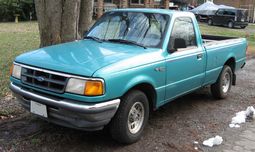

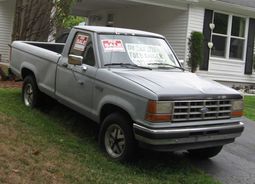
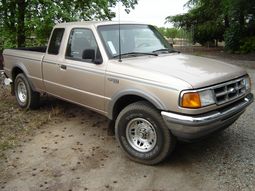




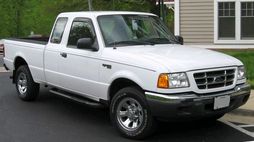
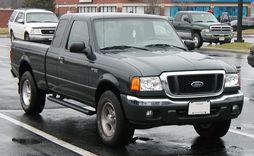
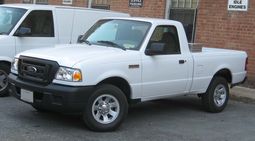
|